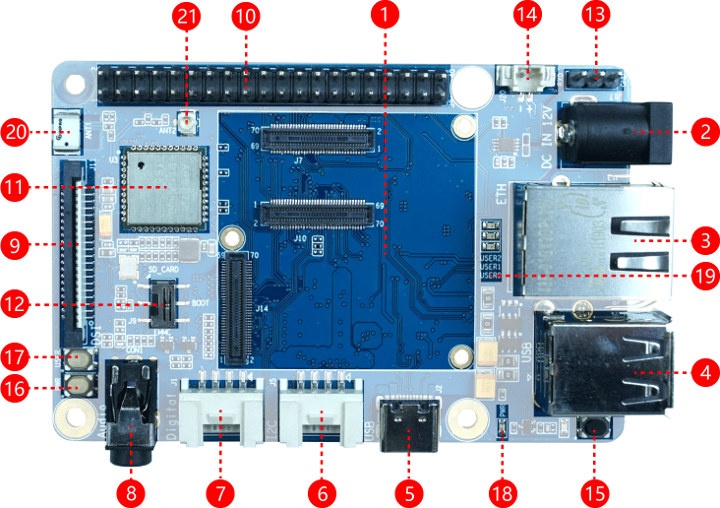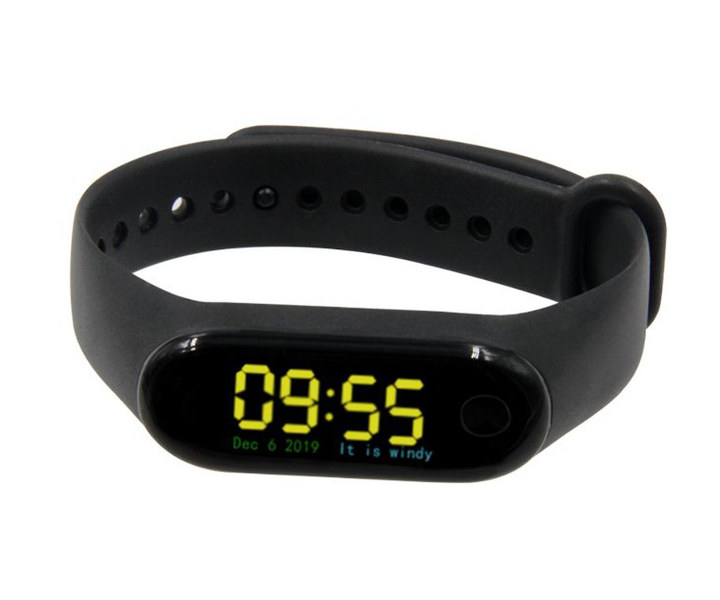Seeed Studio has been working on a single board computer powered by STMicro STM32MP157C Arm Cortex-A7/M4 microprocessor, comprised of the Raspberry Pi inspired NPi-STM32MP157C baseboard, and SoM-STM32MP157C system-on-module. SoM-STM32MP157C SoM Module specifications: MPU (1) – STMicro STM32MP157C dual-core Arm Cortex-A7 processor @ 650 MHz, and Arm Cortex-M4F MCU System Memory (2) – 512MB DDR3 RAM Storage (4) – 4GB eMMC flash Host Connectors – 3x 70-pin board-to-board connectors with HDMI, USB, Gigabit Ethernet, audio GPIOs, etc… Misc – Power and USER LEDs PMU (3) – STPMIC1A power management IC Dimensions – 38mm x 38mm The module is said to targets consumer and industrial applications, white goods, medical equipment, and wearable devices. NPi-STM32MP157C baseboard Key features and specifications: SoM Support – Compatible with SOM-STM32MP157C described above Storage – MicroSD card slot Display I/F – 1x MIPI DSI interface Audio – 3.5mm audio jack, WM8960 audio codec Camera I/F – 1x […]
$18 TTGO T-Wristband DIY Arduino Programmable Smart Bracelet Features ESP32-PICO-D4 SiP
2020 is promising to be an interesting year for low-cost user-flashable smartwatches/bracelets. After the recent introduction of the $25 Pine64 PineTime Bluetooth enabled wearable companion for PinePhone Linux smartphone that will support various real-time operating systems such as Zephyr OS or FreeRTOS, we’ve now been informed that Liliygo launched TTGO T-Wristband smart bracelet powered by Espressif Systems ESP32-PICO-D4 SiP. The watch comes with 802.11 b/g/n WiFi 4 and Bluetooth 4.2 Classic+LE connectivity and is currently selling for under $18 and up on Aliexpress and Tindie. TTGO T-Wristband smart bracelet specifications: SIP – ESP32-PICO-D4 system-in-package with ESP32 Tensilica LX6 dual-core processor, clocked at 240MHz, 520 KB SRAM, 802.11 b/g/n HT40 Wi-Fi, integrated dual-mode Bluetooth (classic + low energy) Display – 0.96″ IPS color display Antenna – WiFi / Bluetooth ceramic antenna Sensor – Invensense MPU9250 9-axis motion sensor Expansion / Programming Interface – 0.3pitch 13-pin FPC socket Misc – NXP PCF8563 […]
Energous Launches WattUp Smart Glasses Developer Kit for Customer Product Designs
Near-field wireless charging technology has the potential to disrupt the consumer electronics industry, but its adoption has been limited. Energous wireless charging technology WattUp has promised to change that narrative by making it possible to charge devices mid-field (on the desk) or far off (in the room. Aside from the distance challenge in wireless charging, one other major issue is the fact that there are few deployments with them. Only a few devices have wireless charging incorporated. Energous is hoping to change that as well with the launch of the WattUp Smart Glasses Developer Kit, which is tailored for custom product design in the wearable industry. Energous is continuing its trend of launching a developer kit after having released the WattUp Hearables Developer Kit with Near-Field Wireless Charging and support for the SKIIN Smart Underwears. According to the Energous, the goal of the smart glasses developer kit is: Designed to […]
Nordic Semi nRF52832 Powered PineTime Dev Kit is Now Available for $24.99
PineTime was announced as a $25 smartwatch & companion for PinePhone Linux smartphone which itself sells for $150. PineTime specifications are still not frozen, but we do know it will be based on Nordic Semi nRF52832 or nRF52840 wireless SoC, come with a 1.3″ 240×240 capacitive touch display, and support a variety of operating systems such as ZephyrOS, FreeRTOS, Arm Mbed or NuttX depending on community involvement. So far it was not available for purchase, but in Pine64’s December update about their various projects, Lukasz Erecinski announced the PineTime dev kit is now available for pre-order for $24.99. PineTime Dev Kit specifications: WiSoC – Nordic Semiconductor nRF52832 ARM Cortex-M4F @ 64 MHz with 512KB Flash, 64KB RAM, Bluetooth 5.0 LE connectivity Storage – 4 MB SPI NOR Flash Display – 1.3″ 240×240 IPS capacitive touchscreen with 65K colors Sensors – Accelerometer, PPG Heart Rate Sensor Actuator – Vibrator Battery Built-in […]
Galerdo AI Swimming Tracker Gives Audio Feedback, Plays Music – No Ear Buds Needed (Crowdfunding)
Galerdo Beker Pro Galerdo is a simple to use, swimmers attendant, that holds tight to the head and collects data. It offers interactive audio, AI advice underwater and even plays music through bone-conduction. We previously reported on fitness and swimming tracker Makibes F69 IP68 Smartwatch but it lacked audio support. Feature Awards for Galerdo Galerdo won the CES 2020 Innovation Award for Swim Tracker, AI Voice Assistant and Handset Free features. Previous and Present Devices Galerdo Inc has a previous bone-conduction audio device that offered music underwater to swimmers, without the need for a headband or earbuds. The latest device simply called Galerdo adds AI data collection and spoken advice as the user is swimming, in real-time. Quick Run Down on Bone-Conduction The AI technology that is used in the Galerdo is further enhanced by the bone-conduction transfer of sound and is a technology industry that is growing rapidly. It […]
Bangle.js is an Hackable, Open Source JavaScript and TensorFlow-driven Smartwatch (Crowdfunding)
Espruino brought JavasScript to the Microcontroller, now Bangle.js is bringing Javascript plus TensorFlow Lite to your smartwatch. There has been some movement by some developers that says that JavaScript should be used for everything, even though I find that idea ridiculous, I still find JavaScript a fascinating language. The NeaForm Research team and Gordon Williams (the brain behind Espruino) have all teamed up in launching Bangle.js Smartwatch. Bangle.js isn’t your ordinary smartwatch, at the heart of it is the open-source ecosystem. JavaScript plus TensorFlow Lite and of course, a cool looking Smartwatch is what Bangle.js is offering. Bangle.js was launched at the recently concluded NodeConf EU conference, and the goal is to bootstrap an Open Health Platform hopefully. NodeWatch is the specific implementation of Bangle.js for NodeConf EU 2019, co-developed by Espruino and NearForm Research. This project has the potential to bootstrap a community-driven open health platform where anyone can […]
Imagination iEW220 Low Power Dual-band 802.11n WiFi IP Solution Targets IoT, Automation and Wearables
Imagination Technologies is better known for their PowetVR GPUs and as the previous owner of MIPS technology, but they do have other products as well and the company just announced their second generation 802.11n WiFi IP designed for low power applications Ensigma iEW220 is an IEEE 802.11a/b/g/n 1X1 SISO Wi-Fi IP solution comprised of RF, baseband and MAC, and supporting both 2.4GHz and 5GHz spectrum. iEW220 specifications: RF Features Dual-band 2.4 and 5 GHz RF including PA Power efficient AGC Optimized PLL power consumption Customized PA to minimize Tx power consumption Power optimized DAC/ADC design Integrated transmit/receive switch for RF Single pin RF antenna interface IEEE 802.11 PHY Support (2.4/5 GHz) IEEE 802.11b DSSS/CCK (up to 11 Mbps) IEEE 802.11a/g OFDM (up to 54 Mbps) IEEE 802.11n OFDM MCS 0-7, (20/40 MHz channels, up to 72.2/150 Mbps) Station, soft AP and Wi-Fi direct with up to four associated devices Tx […]
PineTime Smartwatch Specifications Released, Availability Scheduled for H1 2020
A couple of weeks ago, we covered PineTime smartwatch for PinePhone Linux smartphone that should be launched next year for around $25. At the time we had limited information from a Tweet as well as information provided by TL Lim, founder of Pine64 community, such as the watch would be based on Nordic Semi nRF52832 or nRF52840 multi-protocol WiSoC. But we now have much more details about specs and other details can be found in the Wiki. PineTime specifications: SoC (undecided, one or the other. See differences between nRF52832 and nRF52840 for details) Nordic Semiconductor nRF52832 Arm Cortex-M4F MCU @ 64 MHz with 512KB Flash, 64KB SRAM, Bluetooth 5 (no long range) Nordic Semiconductor nRF52840 Arm Cortex-M4F MCU with 1MB flash, 256KB flash, Bluetooth 5 (long range), 802.15.4 (e.g. for Zigbee), Arm Trustzone, etc… Storage – 8MB SPI NOR Flash (final product may use 16MB flash instead) Display – 1.3″ […]










